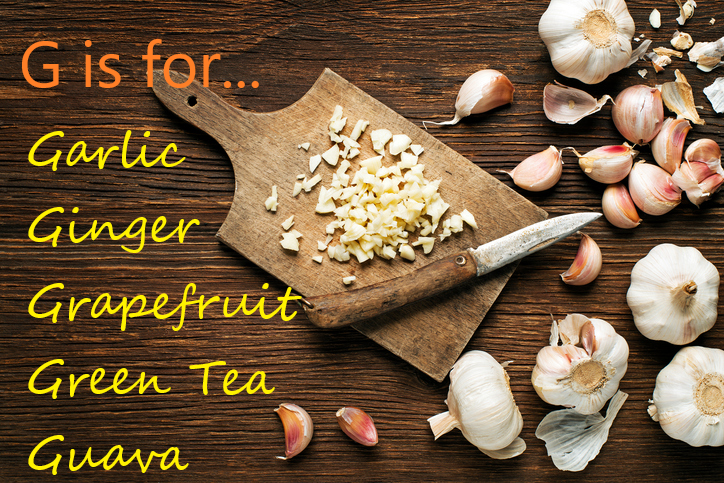Healthy Alphabet: G is For…Five Foods that are Good For You
by Karen Rollins Jul 1, 2019

We are constantly bombarded with information about what we should and shouldn’t be eating which can become confusing.
Yello has decided to go for a simple approach and provide an alphabetical guide to some of the healthiest foods you can add to your diet.
We’ll be going from A-Z and listing up to five fruits and vegetables that are packed with minerals and vitamins while also providing nutritional facts on their health benefits.
We’ve looked at A-F so let’s move on to G.
Garlic
Garlic is a member of the onion family and is said to have originated from Siberia.
Throughout the centuries, garlic has been used for medicinal purposes and has various health benefits which are linked to its sulphur compounds that are believed to boost the immune system.
Garlic is low in calories and rich in vitamin C, manganese, and vitamin B6. It also contains antioxidants and trace amounts of various other nutrients.
Nutrition facts (three cloves):
– 13.4 calories
– 0.2 grams of dietary fibre (1% of daily value (DV))
– 2.8 milligrams (mg) of vitamin C (5% DV)
– 0.1 mg of vitamin B6 (6% DV)
– 1.3 micrograms (mcg) of selenium (2% DV)
– 0.2 mg of manganese (8% DV)
– 16.3 mg of calcium (2% DV)
– 0.6 grams of protein (1% DV)
Ginger
Ginger has been used for over 5,000 years in Indian and Chinese civilisations for its powerful health-imparting properties as well as its taste.
It is packed with nutrients and bioactive compounds which are beneficial for the brain and body and is said to help reduce nausea, aid digestion and combat flu symptoms.
Ginger is very versatile and can be used fresh, dried, powdered, or as an oil. The underground part of the stem is the part commonly used as a spice.
Nutrition facts (1 ounce):
– 22.4 calories
– 0.6 grams of dietary fibre (2% DV)
– 5.0 grams of carbohydrate (2% DV)
– 1.4 mg of vitamin C (2% DV)
– 116 mg of potassium (3% DV)
– 0.1 mg of manganese (3% DV)
– 0.5 grams of protein (1% DV)
– 0.1 mg of copper (3% DV)
Grapefruit
Grapefruit is a tropical citrus fruit known for its sweet to sour taste which can be bitter.
Originating in Barbados as an accidental cross between two introduced species, the main types of grapefruit are white, pink / red, and star ruby / rio red varieties.
They are low in calories and rich in nutrients, antioxidants and fibre, although the red varieties are healthier than the white. Research has shown that grapefruit has various health benefits including reducing the risk of heart disease.
Nutrition facts (1/2 a fruit):
– 51.7 calories
– 2.0 grams of dietary fibre (8% DV)
– 38.4 mg of vitamin C (64% DV)
– 1415 IU of vitamin A (28% DV)
– 108 grams of water
– 166 mg of potassium (5% DV)
– 16.0 mcg of folate (4% DV)
– 0.1 mg of thiamin (4% DV)
Green Tea
Green tea came from China between 4000-5000 years ago and has been used for centuries by the Chinese to improve health.
Green tea has grown in popularity around the world recently and when it’s consumed regularly as part of a healthy diet is said to help reduce the risk of a stroke, enhance cardiovascular function and improve arthritis by reducing inflammation.
It contains potent compounds and antioxidants, notably catechins, which are retained during processing because, unlike other teas, green tea is not fermented. However, green tea does contain some caffeine, so you should limit your intake or choose a decaf option.
Nutrition facts (1 cup unsweetened):
– 2.5 calories
– 0.5 grams of protein
– Up to 80 mg of caffeine (depending on size of cup)
– 7 mg of vitamin C (8% DV)
Guava
Guava is native to the Caribbean and a popular fruit throughout the region where it is consumed raw, as a jam, or a refreshing drink.
Guavas have a high concentration of vitamin C which in some varieties can be five times that of fresh orange juice.
Some of the potential health benefits of guava include its ability to regulate blood pressure. It can also be used for the treatment of coughs and cold, constipation, and diarrhea. (rentalsfloridakeys.com)
Nutrition facts (1 fruit):
– 37.4 calories
– 1.4 grams of protein (3% DV)
– 3.0 grams of dietary fibre (12% DV)
– 126 mg of vitamin C (209% DV)
– 26.9 mcg of folate (7% DV)
– 229 mg of potassium (7% DV)
– 0.1 mg of copper (6% DV)
– 0.1 mg of manganese (6% DV)
Watch out for the rest of the healthy food alphabet in this series to be published on Find Yello, and click to take a look at the previous A, B, C, D, E and F articles.
Sources: The Food Coach / BBC Good Food / Organic Facts / Nutrition Data / WebMD








